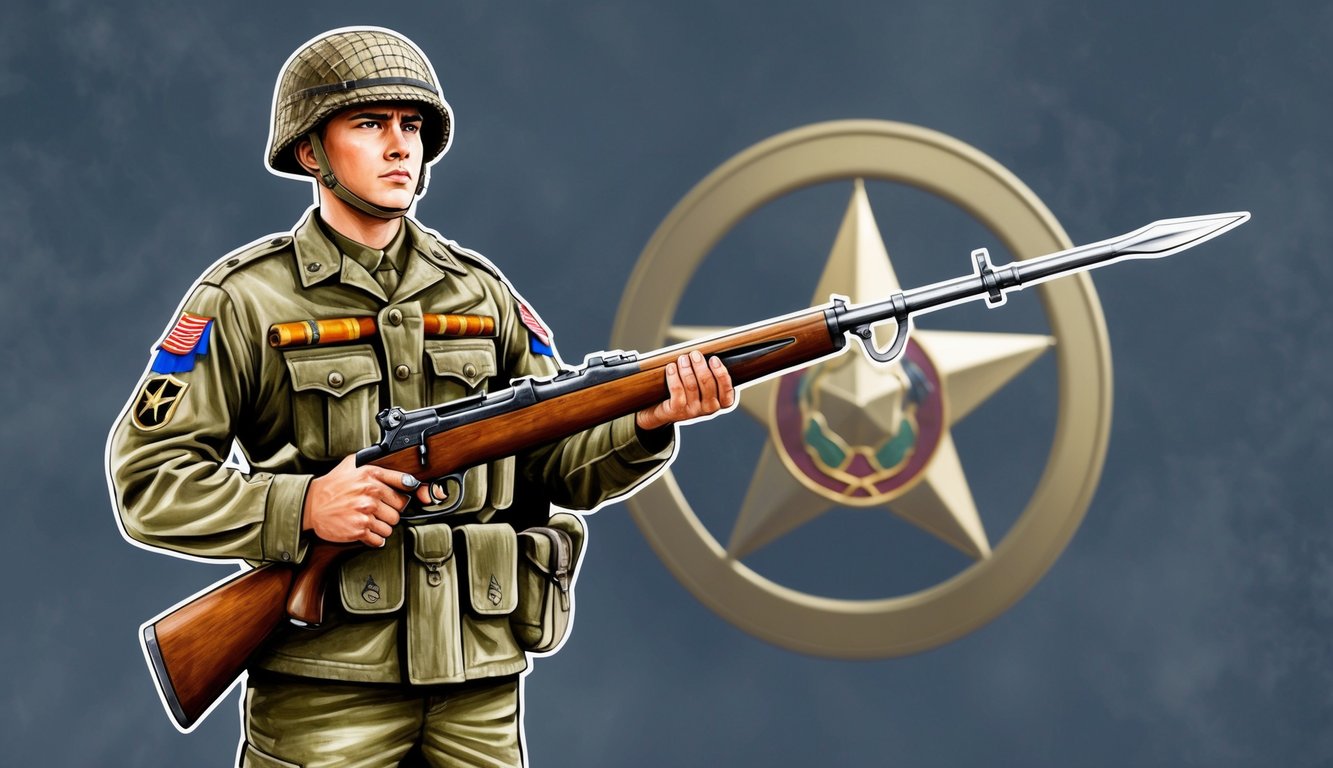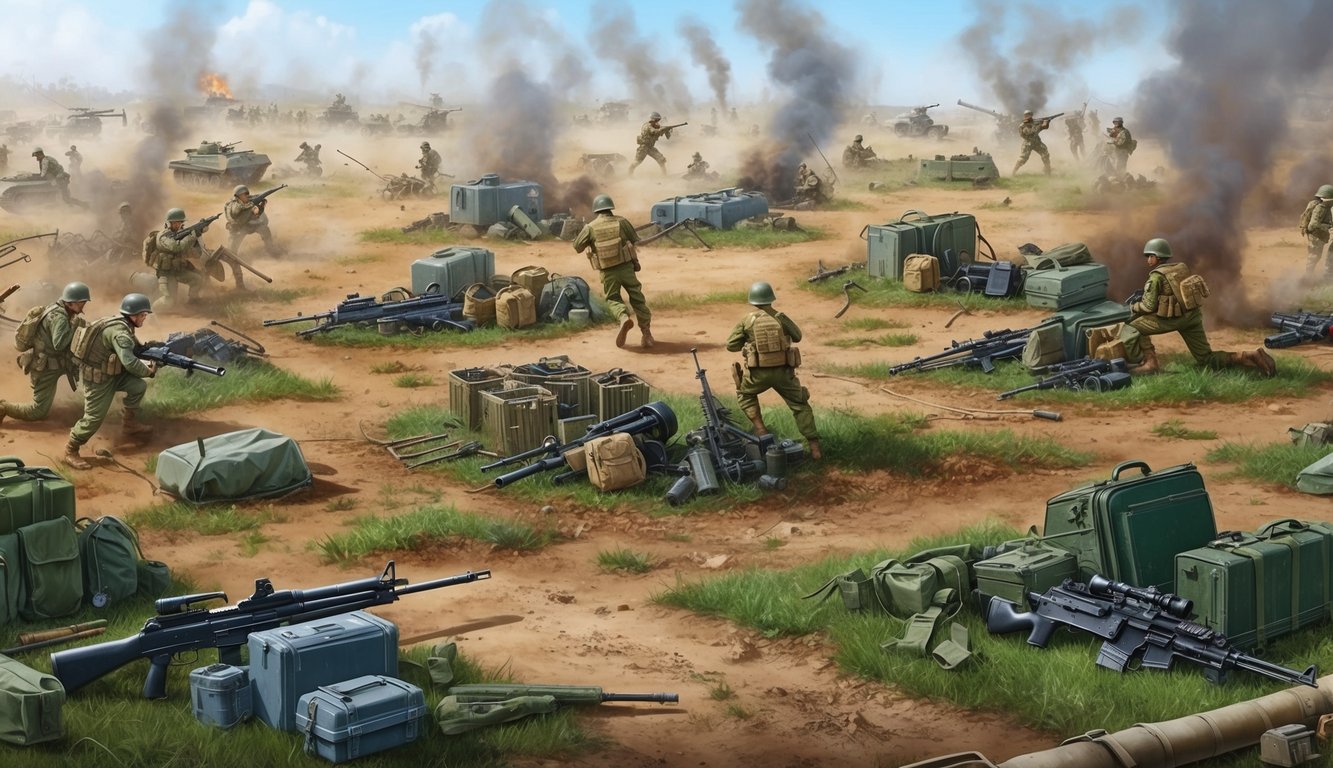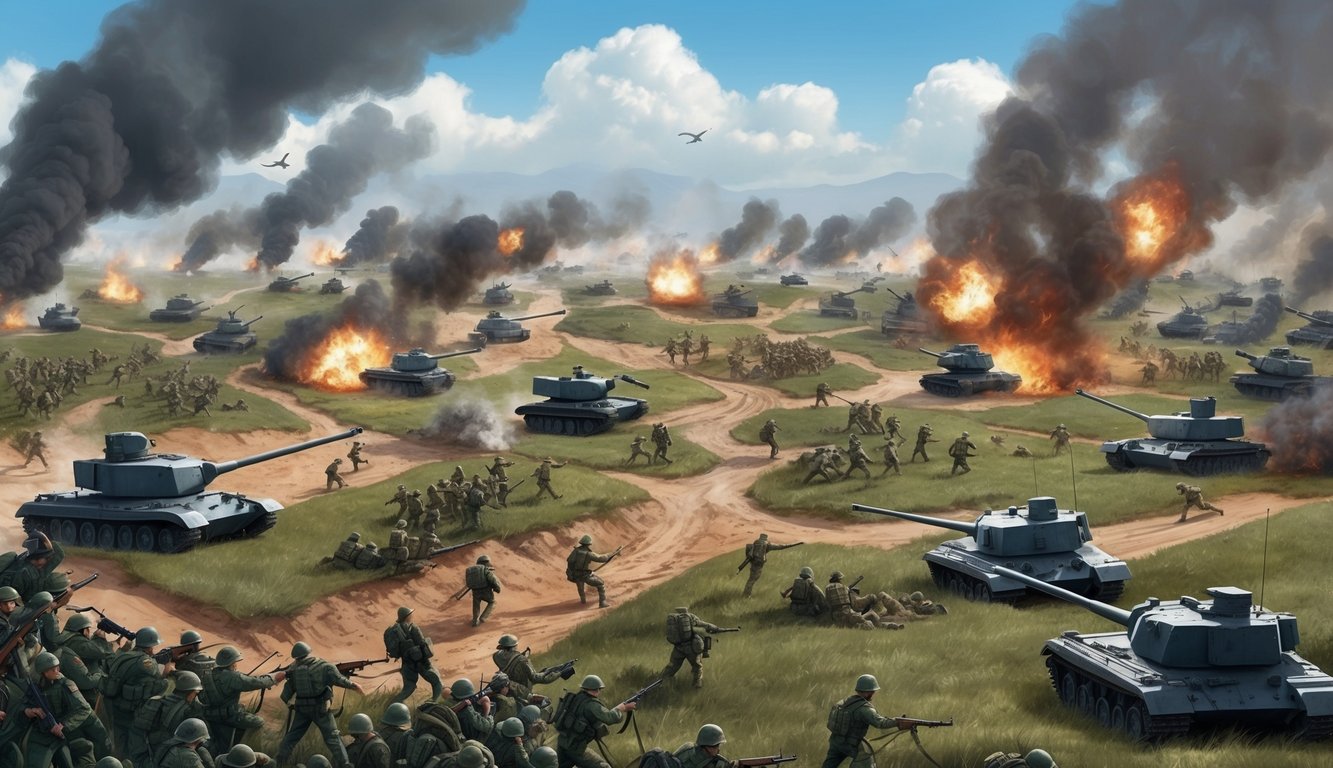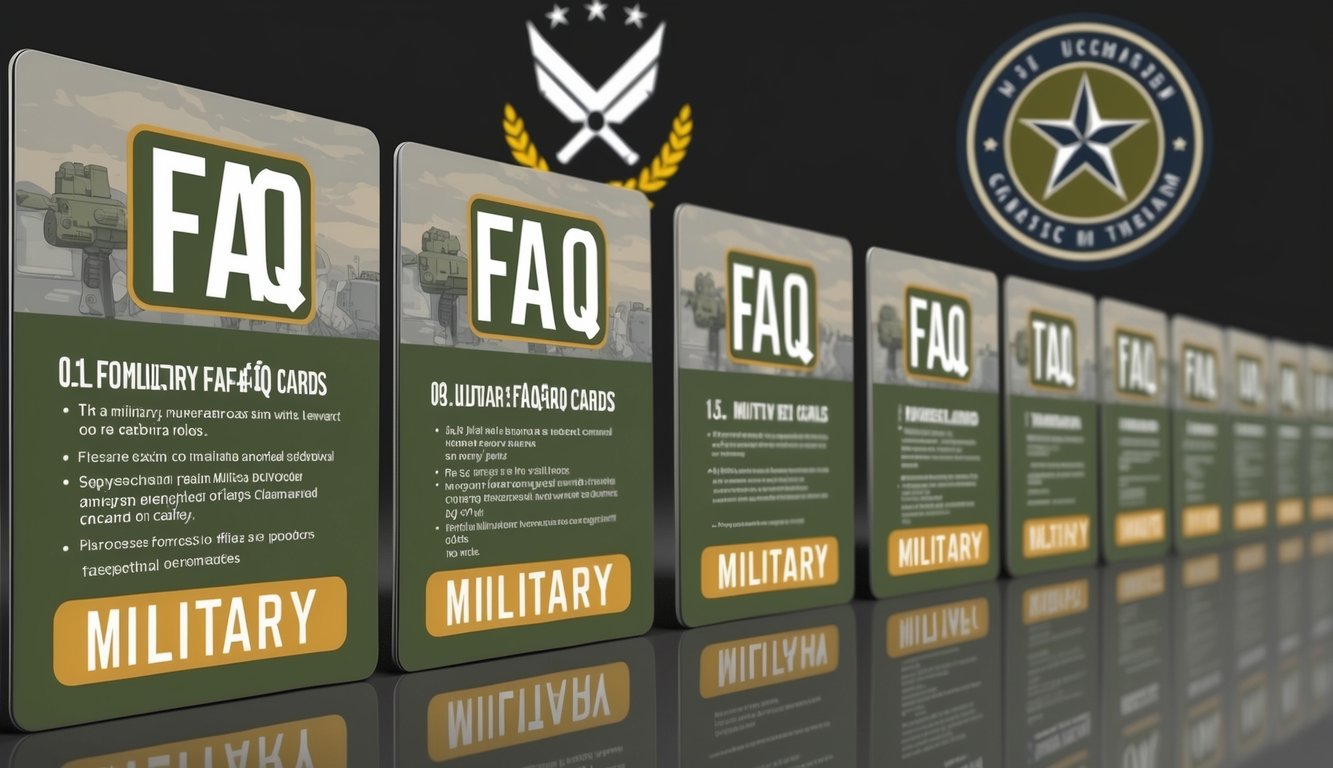Military facts offer a fascinating glimpse into the history, structure, and impact of armed forces around the world. From surprising trivia to significant historical events, these facts reveal the complexities of military life and operations.
The U.S. military alone has played a crucial role in shaping not only American history but also global affairs. Thirty-one out of 45 U.S. presidents have served in the armed forces.
Did you know that the U.S. military once wore blue uniforms? It wasn’t until after the Spanish-American War in 1898 that khaki became the standard. This change reflects the ongoing evolution of military practices and technology.
From uniform colors to advanced weaponry, the military constantly adapts to meet new challenges and maintain effectiveness.
The impact of military conflicts on history cannot be overstated. The American Civil War, for instance, stands as the bloodiest war in U.S. military history, with over 618,000 lives lost. This sobering fact reminds us of the immense sacrifices made by service members throughout history and the profound consequences of warfare.
Key Takeaways
- The U.S. military has a rich history of presidential leadership and uniform evolution.
- Military conflicts have shaped nations and led to significant technological advancements.
- Armed forces continue to adapt and innovate in response to changing global challenges.
History of the U.S. Armed Forces
The U.S. Armed Forces have a rich history spanning nearly 250 years. From humble beginnings to becoming a global superpower, America’s military has played a crucial role in shaping the nation and world events.
Formation and Early Engagements
The Continental Army, established in 1775, marked the birth of the U.S. military. You might be surprised to learn that George Washington, the first U.S. president, led this fledgling force during the Revolutionary War.
After gaining independence, the new nation faced various challenges. The Lewis and Clark Expedition (1804-1806) helped map the western territories, expanding America’s reach.
In 1846, you’d have witnessed the Mexican-American War, where future Civil War generals like Ulysses S. Grant and Robert E. Lee cut their teeth. This conflict significantly expanded U.S. territory, adding California and much of the Southwest to the map.
Important Conflicts and Wars
The Civil War (1861-1865) tested the nation’s resolve and military might. You’d have seen brother fighting against brother in this devastating conflict that reshaped America. The Union Army, led by generals like Grant and Sherman, eventually prevailed over the Confederate forces.
World War II (1941-1945) saw the U.S. military reach unprecedented levels of power and global influence. You’d have been amazed by the massive mobilization effort, with millions of Americans joining the armed forces. The U.S. played a crucial role in defeating Nazi Germany and Imperial Japan, emerging as a superpower.
Modern Military Engagements
Since WWII, you’ve seen the U.S. military involved in numerous conflicts worldwide. The Cold War era saw engagements in Korea and Vietnam, while more recent operations have focused on the Middle East and counterterrorism efforts.
Today, you’ll find the U.S. Armed Forces comprised of six branches: Army, Navy, Air Force, Marine Corps, Coast Guard, and the newly formed Space Force. With cutting-edge technology and a global presence, America’s military continues to adapt to evolving threats and challenges in the 21st century.
Branches of the U.S. Military
The U.S. military consists of six main branches, each with its own unique role and capabilities. These branches work together to defend the nation and its interests both at home and abroad.
Army
The U.S. Army is the largest and oldest branch of the military. It’s responsible for land-based military operations and national defense.
As an Army soldier, you’d be part of a force that dates back to 1775. Your primary duties would involve ground combat, but you might also work in areas like intelligence, engineering, or medical care.
The Army uses a wide range of equipment, from tanks and helicopters to advanced communication systems. You’d have opportunities to specialize in various fields, such as infantry, artillery, or cyber operations.
Navy
The U.S. Navy protects American interests at sea and supports global maritime security.
As a Navy sailor, you’d serve on ships, submarines, or aircraft carriers. Your duties could range from navigation and weapons systems operation to aircraft maintenance or underwater demolition.
The Navy employs cutting-edge technology, including guided-missile destroyers and nuclear-powered submarines. You might find yourself operating sophisticated radar systems or piloting naval aircraft.
Naval operations often involve long deployments at sea, offering you the chance to see the world while serving your country.
Air Force
The U.S. Air Force is responsible for aerial warfare and space operations.
As an Air Force member, you’d be part of a high-tech force that controls the skies. Your role could involve piloting aircraft, maintaining advanced systems, or managing air traffic control.
The Air Force operates a diverse fleet of aircraft, from supersonic fighters to strategic bombers and large cargo planes. You might work with state-of-the-art technology like drones or satellite systems.
Cybersecurity and space operations are growing fields within the Air Force, offering exciting opportunities for those interested in cutting-edge technology.
Marine Corps
The Marine Corps is a component of the Department of the Navy and serves as the U.S. military’s rapid reaction force.
As a Marine, you’d be part of an elite fighting force known for its toughness and versatility. Marines are often the first troops deployed in crisis situations.
Your training would emphasize physical fitness, combat skills, and leadership. Marine Corps missions can range from combat operations to humanitarian assistance.
The Corps operates on land, sea, and air, using a variety of vehicles and aircraft. You might find yourself in an amphibious assault vehicle one day and piloting a helicopter the next.
Coast Guard
The U.S. Coast Guard is unique as it operates under the Department of Homeland Security during peacetime, switching to Navy control during wartime.
As a Coast Guard member, you’d focus on maritime law enforcement, search and rescue, and environmental protection. Your duties might include intercepting drug smugglers, rescuing stranded boaters, or responding to oil spills.
The Coast Guard uses a variety of vessels, from small patrol boats to large cutters. You’d learn skills like navigation, maritime law, and emergency response.
Coast Guard service often involves working closely with civilian agencies and can be an excellent choice if you’re interested in law enforcement or environmental protection.
Reserve and Guard Forces
Reserve and National Guard units support the active-duty military while allowing members to serve part-time.
As a reservist or guard member, you’d typically train one weekend a month and two weeks a year. You might be called to active duty during national emergencies or to support overseas operations.
The Army, Navy, Air Force, and Marine Corps all have reserve components. The Army and Air Force also have National Guard units, which can be activated by state governors for local emergencies.
Reserve and Guard service offers a way to gain military experience and benefits while maintaining a civilian career. You’d receive specialized training and could be called upon to support both military operations and disaster relief efforts.
Roles and Responsibilities

The military has diverse roles and responsibilities that encompass active duty, reserves, and specialized units. Leadership structures and different force components work together to maintain national security and respond to various threats.
Active Duty vs. Reserve Forces
Active duty personnel serve full-time in the military, while reserve forces maintain civilian jobs and train part-time. You’ll find active duty members living on or near military bases, ready for immediate deployment. They handle day-to-day operations and are the first line of defense.
Reserve forces, on the other hand, provide additional support when needed. You can think of them as a backup team, ready to step in during emergencies or large-scale operations. They typically train one weekend a month and two weeks a year, balancing military service with civilian careers.
Both components are crucial for maintaining a strong military presence. Active duty ensures constant readiness, while reserves offer flexibility and cost-effectiveness.
Military Leadership
Military leadership is structured hierarchically, with officers and non-commissioned officers (NCOs) playing distinct roles. As an officer, you’d be responsible for planning missions, making strategic decisions, and leading large groups of personnel.
NCOs, often called the backbone of the armed forces, serve as technical experts and direct leaders. You’d find them training and mentoring junior enlisted members, ensuring discipline, and executing officers’ orders.
Leadership in the military isn’t just about rank; it’s about responsibility and expertise. Whether you’re an officer or NCO, your role is crucial in maintaining unit cohesion and achieving mission objectives.
Specialized Military Units
The military has various specialized units designed for specific tasks and environments. These units undergo rigorous training to excel in their unique roles.
Special Forces, like Navy SEALs or Army Green Berets, handle high-risk missions and unconventional warfare. You’d find them conducting covert operations, counter-terrorism, and training foreign allies.
Other specialized units include:
- Cyber warfare teams
- Medical corps
- Engineering battalions
- Air defense artillery
Each unit brings essential skills to the table, contributing to the overall effectiveness of the armed forces. Whether you’re interested in cutting-edge technology or frontline combat, there’s likely a specialized unit that matches your skills and interests.
Notable Figures and Contributions

The U.S. military has been shaped by exceptional individuals who have left an indelible mark on history. From brave soldiers to visionary leaders and innovative thinkers, these figures have profoundly influenced military culture and capabilities.
Medal of Honor Recipients
The Medal of Honor is the highest military decoration awarded for valor in combat. Recipients have shown extraordinary courage and selflessness in the face of extreme danger.
Did you know that only 3,500 service members have received this prestigious award since its creation in 1861? That’s less than 0.1% of all who have served!
Some notable recipients include:
- Audie Murphy: The most decorated U.S. soldier in World War II
- Desmond Doss: The first conscientious objector to receive the Medal of Honor
- Mary Walker: The only woman to receive the medal to date
These heroes’ actions inspire and remind us of the incredible sacrifices made by our armed forces.
Presidents Who Served
Many U.S. presidents have proudly worn the uniform before taking office. Their military experiences often shaped their leadership styles and policy decisions.
George Washington, the nation’s first president, set the precedent as Commander-in-Chief of the Continental Army during the Revolutionary War.
Other notable presidents with military service include:
- Dwight D. Eisenhower: Supreme Allied Commander in World War II
- John F. Kennedy: Navy Lieutenant in World War II
- George H.W. Bush: Youngest Navy pilot in World War II
Did you know that 31 of the 45 U.S. presidents have served in the military? Their combined experiences span from the Revolutionary War to the Vietnam War.
Military Innovators
Throughout history, innovative thinkers have revolutionized military technology and strategy. Their contributions have dramatically changed the face of warfare and often spilled over into civilian applications.
Key innovators include:
- Robert Fulton: Developed the submarine and torpedo
- Igor Sikorsky: Pioneered helicopter design
- Grace Hopper: Created the first compiler for computer programming
You might be surprised to learn that many everyday items, like GPS and the internet, have roots in military research and development.
These innovators’ work continues to shape both military capabilities and civilian technology, highlighting the far-reaching impact of military advancements.
Military Infrastructure
Military infrastructure forms the backbone of national defense capabilities. It encompasses a vast network of facilities and installations that support military operations, training, and readiness.
Domestic Military Bases
You’ll find military bases spread across the United States, serving various branches of the armed forces. These installations range from sprawling army posts to specialized air force bases and naval stations. Fort Bragg in North Carolina, for instance, is one of the largest military complexes in the world. It houses over 50,000 active duty personnel.
Many bases also serve as economic engines for surrounding communities. They provide jobs and stimulate local businesses. Some installations focus on specific functions like training or logistics. Others host multiple units and capabilities.
The Department of Defense regularly evaluates these facilities to ensure they meet evolving strategic needs. Base realignment and closure processes have reshaped the domestic base structure over the years.
Overseas Installations
The U.S. maintains a significant presence abroad through its network of overseas bases. These installations support global operations, strengthen alliances, and project power. You’ll find major U.S. military hubs in countries like Germany, Japan, and South Korea.
Overseas bases vary in size and purpose. Some are large air bases or naval facilities, while others are smaller cooperative security locations. These installations allow for rapid response to regional crises and support ongoing operations.
The exact number of overseas bases is debated, but estimates suggest hundreds of facilities across dozens of countries. This global footprint is unique among nations and reflects the U.S. role in international security.
The Pentagon
At the heart of U.S. military infrastructure sits the Pentagon. This iconic five-sided building in Arlington, Virginia, serves as the headquarters of the Department of Defense. It’s one of the world’s largest office buildings, covering 6.5 million square feet.
Roughly 23,000 military and civilian employees work at the Pentagon daily. The building houses command centers, offices, and support facilities crucial for coordinating U.S. military operations worldwide.
Built during World War II, the Pentagon has undergone several renovations to modernize its infrastructure. It remains a symbol of U.S. military power and a nerve center for national defense planning and execution.
Impact on Society and Culture

Military institutions profoundly shape society beyond their primary defense roles. Their influence extends to family structures, economic landscapes, and cultural perceptions.
Military Families and Life
Living as part of a military family comes with unique challenges and rewards. You’ll find that frequent relocations are common, often every 2-3 years. This nomadic lifestyle can impact children’s education and spouses’ careers.
Military families develop strong support networks to cope with deployments and separations. On-base housing and schools create tight-knit communities.
You’ll notice military values like discipline and teamwork often carry over into family life. These qualities can foster resilience but may also lead to communication challenges in civilian settings.
Economic Influence of the Military
The military’s economic impact is substantial. You’ll see its effects in defense-heavy regions and across the nation.
Military bases boost local economies through job creation and spending. In some towns, they’re the primary employer.
The defense budget, often exceeding $700 billion annually, drives innovation in various sectors. You benefit from military-developed technologies like GPS and the internet in your daily life.
Defense contracts support numerous industries, from aerospace to textiles. This creates a ripple effect, indirectly supporting millions of civilian jobs.
Cultural Representation and Perception
Military culture permeates society in various ways. You encounter it in movies, TV shows, and video games, shaping public perceptions.
Media often portrays service members as heroes or troubled veterans, influencing how you view the military. These representations can oversimplify the diverse experiences of military personnel.
Military language and customs have seeped into civilian life. You might use phrases like “roger that” or “mission accomplished” without realizing their origins.
Public opinion of the military fluctuates with current events and conflicts. You may notice shifts in support during wartime versus peacetime.
Military Innovations and Contributions
Military advancements have shaped technology, medicine, and exploration in profound ways. These innovations have transformed not just warfare, but many aspects of civilian life as well.
Technological Advancements
Military technology has driven many breakthroughs that now impact your daily life. The internet, for example, evolved from ARPANET, a U.S. Department of Defense project. GPS, which you likely use for navigation, was originally developed for military purposes.
Drones, once purely military tools, are now used in photography, delivery services, and search and rescue operations. You can even buy consumer drones for recreational use.
Military research has also contributed to advancements in robotics, artificial intelligence, and cybersecurity. These technologies are increasingly important in both military and civilian contexts.
Health and Medicine
Military medical innovations have saved countless lives on and off the battlefield. Techniques developed to treat combat injuries are now used in emergency rooms worldwide.
You benefit from military medical advancements every day. Blood banks, which ensure a ready supply of blood for transfusions, were first developed during World War I.
Penicillin was mass-produced for military use in World War II, paving the way for widespread antibiotic use. Military research has also contributed to advancements in prosthetics, helping both veterans and civilians regain mobility.
Navigation and Exploration
Military needs have driven significant advances in navigation and exploration technologies. GPS, initially a military system, now helps you find your way in unfamiliar places.
Satellite technology, developed for military reconnaissance, now provides you with weather forecasts and enables global communications. Military aerospace research has contributed to civilian aviation advancements, making air travel safer and more efficient.
Underwater exploration techniques, originally developed for naval purposes, now aid in oceanographic research and offshore resource exploration. These innovations continue to expand our understanding of the world around us.
Awards and Decorations
Ever wondered about those shiny medals and colorful ribbons adorning military uniforms? They’re not just for show! These awards recognize exceptional service, bravery, and accomplishments of U.S. Armed Forces members.
The Medal of Honor stands at the pinnacle of military decorations. It’s awarded for extraordinary valor in combat, often at great personal risk. You might have seen it depicted in movies – it’s that prestigious!
Another well-known award is the Purple Heart. This one’s given to those wounded or killed in action. It’s a somber recognition of sacrifice that dates back to the Revolutionary War.
Did you know there’s a specific order for wearing these awards? It’s called the order of precedence. The Medal of Honor always comes first, followed by other combat decorations, then non-combat awards.
Military decorations aren’t just for individuals. Entire units can receive awards too! These recognize collective achievements and foster team pride.
Next time you see a service member in uniform, take a moment to appreciate those ribbons and medals. Each one tells a story of dedication, service, and sometimes heroism.
Challenges and Controversies

The military faces complex issues that spark debate and shape its operations. From conscription policies to legal frameworks and ethical dilemmas, these challenges impact service members and civilians alike.
Conscription and Draft History
You might be surprised to learn that the U.S. hasn’t used a military draft since 1973. The shift to an all-volunteer force came after years of controversy surrounding the Vietnam War. Prior to that, conscription played a crucial role in both World Wars and the Korean War.
Today, you’re still required to register for Selective Service if you’re a male between 18 and 25. This system remains in place in case a draft is ever needed again. Some argue for its elimination, while others push for expanding registration to include women.
The debate over conscription continues, with questions about fairness, military readiness, and civic duty at its core.
Regulatory and Legal Issues
The Uniform Code of Military Justice (UCMJ) governs the legal framework for U.S. service members. It’s a unique system that can sometimes clash with civilian laws and expectations.
You might face different rules and punishments in the military compared to civilian life. For example, adultery can be a criminal offense under the UCMJ. This has led to debates about personal privacy and military discipline.
Another hot topic is the handling of sexual assault cases within the military justice system. Recent reforms aim to address concerns about victim protection and fair trials.
The military must also navigate complex international laws, especially in combat zones. This includes rules of engagement and treatment of prisoners.
Ethical and Political Debates
The military’s role in society often sparks intense discussions. You might hear debates about the size of the nuclear arsenal and its impact on global security. Some argue for disarmament, while others emphasize deterrence.
The use of drones and AI in warfare raises ethical questions about remote killing and accountability. You’re likely to see more discussions on this as technology advances.
Political neutrality is another key issue. Service members are expected to remain apolitical while in uniform, but this can be challenging in today’s polarized climate.
Debates also surround military spending, with arguments for and against increasing the defense budget. This ties into broader discussions about national priorities and global responsibilities.
Frequently Asked Questions

Military service involves unique experiences, rich histories, and significant impacts on technology and society. Let’s explore some common questions about military life, traditions, and global comparisons.
What are some interesting facts about life as a soldier?
Basic training typically lasts 8-12 weeks, pushing recruits to their physical and mental limits. Soldiers often develop strong bonds with their fellow service members, forming lifelong friendships.
Military personnel may be stationed in various locations around the world, experiencing different cultures firsthand. They also receive specialized training in their chosen fields, from mechanics to intelligence.
Could you tell me a bit about the history of military branches?
The U.S. Army, established in 1775, is the oldest branch of the military. The Navy and Marine Corps followed shortly after in 1775 and 1798, respectively.
The Air Force, originally part of the Army, became a separate branch in 1947. The Coast Guard, created in 1915, serves under the Department of Homeland Security during peacetime.
How does the U.S. military’s strength compare to other countries?
The U.S. military is widely regarded as the most powerful in the world. It boasts the largest defense budget, advanced technology, and a global presence.
American forces have significant air and naval superiority, with the world’s largest aircraft carrier fleet. The U.S. also maintains a vast network of international military bases.
What are some ways the military has impacted technology?
Many everyday technologies have military origins. GPS, initially developed for military navigation, is now ubiquitous in civilian life.
The internet began as ARPANET, a Department of Defense project. Microwave ovens were invented after a scientist noticed radar waves melted a chocolate bar in his pocket.
Can you list some notable statistics about military recruitment?
About 1% of the U.S. population serves in the military. The Army is the largest branch, followed by the Navy, Air Force, Marine Corps, and Coast Guard.
Women make up approximately 16% of the active-duty force. The military offers various enlistment bonuses and educational benefits to attract recruits.
What are some unique traditions in the various branches of the military?
The Navy has a tradition of “crossing the line” ceremonies when ships cross the equator. During the ceremony, new sailors are initiated as “shellbacks” in a festive celebration.
Air Force pilots often receive call signs, unique nicknames that stick with them throughout their careers. These names often stem from embarrassing incidents or personality traits.
